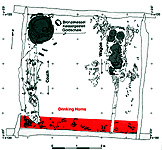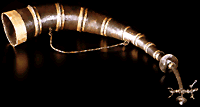I. Find Situation
II. Original Placement
Drinking Horns
View of restored bronze and iron drinking horn with gold foil ornament. Length ca. 89 cm; diameter at lip ca. 14.5 cm; weight ca. 2.7 kg; capacity 5.5 liters. Missing in the photo are the pendant objects made of horn and bone that were probably suspended from the antenna-shaped finial. The iron horn is the best preserved of the nine drinking horns found in the tomb.
I. Find Situation

The plan shows the tomb chamber as seen from above, with the area (shaded in red) where the remains of nine drinking horns were found along the south and west walls. The large iron drinking horn hung above the head end of the couch was broken and crushed but could be reconstructed; some gold foil details and parts of the pendants of bone or horn remain somewhat speculative. However, the other drinking horns were originally made of animal horn; only the bronze fittings that functioned as sleeves to hold the hanging wires in place, some gold foil, and several bone or horn finials are preserved. The information concerning the organic horns is not nearly as complete as what can be determined about the iron horn; much of the data derives from reconstructions based on the fragmentary finds.
II. Original Placement
The nine drinking horns were attached by means of iron hooks to the textile-covered wooden walls of the burial chamber -- the textiles themselves were attached with iron hooks and serpentine fibulae. It is not always clear which hooks go with which items, and the poor preservation of the horn remains has contributed to several quite different reconstructions of the original placement of the assemblage. Krauße's exhaustive 1996 study places one organic horn along the west wall with the opening facing south, quite near the corner of the chamber at the head end of the couch. The iron horn faces the same corner along the south wall, while the remaining horns are lined up along the south wall with all the openings facing east. It is not entirely clear to me that the iron horn should be arranged differently from the organic horns -- the find situation, with the antenna-shaped finial and bone pendants to the east and approximately the lower half of the conical body sections folded over the top half, might be explained by a fall onto the end with the opening, with the lower half flipping over the top and to the east as the horn disintegrates. We do not know the height at which the horns were hung, but Krauße assumes, I think rightly, that they would not have been placed much below the top of the chamber, which was approximately 1.2 m high (1996, 48).
Publication: Krauße 1996; also Biel 1985, 92, f., 149 f.
Stuttgart: Württembergisches Landesmuseum.
Original images courtesy Württembergisches Landesmuseum; some digitally altered and reassembled after photographs published by D. Krauße and J. Biel.



